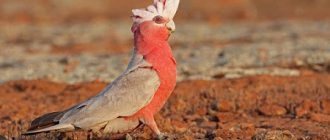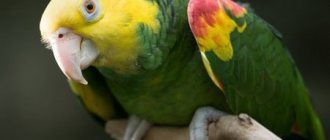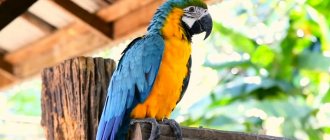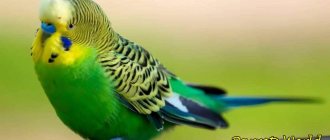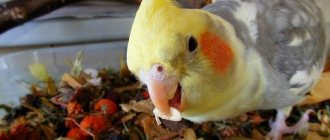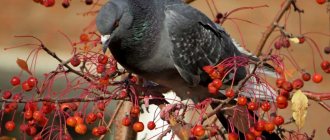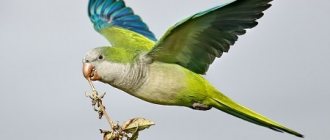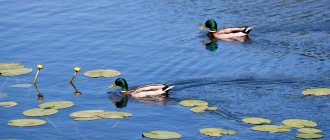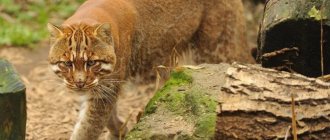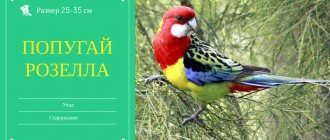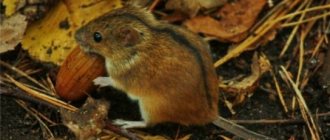The magnificent red macaw parrot is one of the most beautiful birds on the planet. This is a large parrot with bright plumage, regal bearing and piercing eyes. The Macau macaw is valued very highly, so it is quite difficult to acquire and keep this majestic bird. In captivity, macaws can be seen in zoos and circuses, as well as among lovers of exotic birds. The article describes the life of a grandiose bird in nature, the features of its character and appearance. The nuances of home maintenance are considered and information on purchasing a red macaw is provided.
Top 10 most famous species with photos
Among other wild representatives of the family, ornithologists have identified several large birds that adapt well to life in captivity and can please the owner not only with their impressive size, but also with their intelligence.
White cockatoo Alba
The body length of the largest bird does not exceed 50 cm and weighs 600 g . The plumage is bright white, and yellowish zones can be seen in the underwing zone. One of the notable features of the cockatoo is the presence of a crest, which acts as an indicator of the parrot's mood.
The species is distributed on the Indonesian group of islands. The bird prefers to inhabit forests near bodies of water. Animals lead a sedentary lifestyle, gathering in groups of 40-50 individuals. If there is a lack of food, they can migrate to neighboring islands.
White cockatoos form pairs for life. If one of the partners dies, the other becomes severely depressed and subsequently makes no attempt to find a replacement.
The cockatoo is trusting and easily makes contact with people. He has a natural artistic gift and is also able to learn up to 20 words. In captivity, with proper care, the bird's life expectancy is about 50-70 years.
Moluccan cockatoo
The body length of a mature animal varies between 46-52 cm and weighs 850 g. The dominant color of the plumage is white. The chest and abdomen are highlighted in a pale pink shade. The male is no different in color from the female. The length of the crest reaches 15 cm.
The main population is concentrated in the Moluccas . The parrot inhabits tropical rainforests and coastal areas. The animals keep in small groups of 20 birds, split into pairs. The number of representatives of this species has dropped below 10,000 individuals. Since 1960, the Moluccan cockatoo has been listed in the Red Book.
The parrot easily adapts to life in captivity and quickly gets used to human hands. The bird is intelligent, but problems arise when imitating human speech. The maximum you can count on is a dozen words and phrases. The life expectancy of a pet is 50-80 years.
Black palm cockatoo
The bird's body length is about 80 cm and weighs 900 g. The predominant color of the plumage is black and slate. A greenish tint can be seen in the rays of the sun. A notable feature of palm cockatoos is their large and at the same time powerful beak, growing up to 9 cm. The crest consists of ribbon-like feathers curled back. Scarlet-red areas are noticeable on the cheeks.
The parrot lives in New Guinea and northern Australia, inhabiting savannas and tropical forests. Birds can survive either in groups or alone. In search of food, they deftly maneuver through dense thickets of tall trees.
The voice of the black palm cockatoo is quite unpleasant: loud, harsh and squeaky. Especially in an excited state.
The bird is most often kept in zoos. The powerful beak of a cockatoo can bite through 5 mm thick metal rods. Therefore, the only place from which a parrot will not escape is an aviary with a strong lattice. The pet is quite demanding in terms of training and training: mistakes can provoke aggression.
In addition, palm cockatoos are vindictive and remember everything that a particular person has done. However, the bird is considered one of the smartest among other members of the family. She is capable of performing very difficult tricks for birds.
Greater yellow-crested cockatoo
The body length reaches 50-55 cm with a weight of about 950 g. The dominant color of the plumage is white with rare yellow accents: flight and tail feathers, crest. The size of the beak is proportional to the size of the bird and is strongly curved.
The largest populations are found on the islands of Tasmania, New Guinea and the northern part of Australia. The parrot prefers eucalyptus forests and savannas with tall, dense trees located near bodies of water. Both parents, not just the female, participate in the arrangement of the nest. The bird feeds on fruits, nuts, and plant buds, but does not hesitate to fly onto farm lands.
The yellow-crested cockatoo has great difficulty imitating human speech and is not able to master more than 10 words. But the pet perfectly copies other sounds: barking dogs, meowing, simple musical compositions, the operation of household appliances, etc. Like other cockatoos, the yellow-crested cockatoo has innate artistry, which is why it can often be seen at circus performances. The bird's lifespan is about 50 years.
Yellow-eared mourning cockatoo
The bird's body length fluctuates around 60 cm and weighs almost a kilogram. The plumage is dark brown, and rare light spots are scattered throughout the body. There are several yellow stripes at the tip of the tail. Unlike other members of the family, mourning cockatoos have virtually no crest.
The main population of birds is concentrated in eastern Australia and the islands adjacent to this part of the mainland. The animal's diet consists of insect larvae and plant seeds. Ornithologists do not recommend considering mourning cockatoos as pets. The parrot is picky both in content and in training. The bird is suitable only for experienced breeders.
The female mourning cockatoo lays 1-2 eggs, and the male provides her with food. As a rule, only one chick survives. Moreover, it remains in the nest not for 30-60 days, like other parrots, but for about six months.
Hyacinth macaw
The length of mature individuals can reach 90-100 cm , and the weight of domestic animals often exceeds 1.5 kg. The plumage of this huge parrot is matte cobalt blue. Bright yellow stripes are visible around the eyes and above the beak. The beak looks hypertrophied considering the size of the bird. With its help, she easily cracks nuts and other hard objects.
The habitat of the hyacinth macaw is Brazil, Paraguay and Bolivia. The parrot inhabits palm groves and forest plantations near bodies of water. Birds live in small groups of a dozen individuals each. In search of food, they can fly over an area up to 10 km away. The animal's favorite delicacy is berries, figs and snails.
Despite its complex nature, the hyacinth macaw is easy to train and relatively quickly gets used to human hands. The parrot imitates sounds well, including human speech: its vocabulary is limited to 40-50 words. Life expectancy is about 40-50 years.
The hyacinth macaw is endangered. At the beginning of the 21st century, the number of wild birds had decreased to 6,000 individuals. Therefore, the species is listed in the Red Book.
Red Macaw (Macao)
The parrot's body length is 80-90 cm and weighs 1.2 kg. The coloring is the calling card of the red macaw. Most of the plumage is painted bright red, the rest of the area is combined in blue, yellow and brown shades. The beak and part of the head have white areas.
The bird population is dispersed from Mexico to Uruguay. The red macaw inhabits tropical forests, nesting high in the treetops. The main diet of the animal is plant food: seeds, nuts and fruits. It also does not disdain insects.
In search of food, the parrot may fly into farmland. Given its gluttony, it causes serious damage to agricultural crops. The bird can cover about 15 km in a day. Partners become attached both to each other and to the nesting site.
The Indians hunted the red macaw for a living. Feathers were used to make arrows and organize ritual ceremonies, and parrot meat was considered a delicacy.
The bird quickly adapts to captivity and easily gets used to human hands. With the right approach, the red macaw can learn up to 100 words and consciously use phrases. The parrot is also capable of performing complex tricks. Life expectancy in captivity is about 40-50 years.
Blue and yellow macaw
This is one of the most popular among other large domesticated birds. The parrot's body length is 80-90 cm, and its weight reaches 1.3 kg. The plumage is dominated by two colors - yellow and blue, visually dividing the body into two parts. There are two white areas with black stripes on the head. The beak is massive and powerful. With its help, the parrot not only cracks nuts, but also easily bites through wooden branches.
The bird lives from Panama to the southern regions of Brazil, preferring to nest in tropical forests closer to water. Sometimes found in mountainous areas. The animal becomes strongly attached to its habitat and only leaves it in case of extreme need. In search of food, it can travel up to 25 km. Birds do not form groups, living exclusively in pairs.
Taking into account other representatives of the parrot family, the blue-and-yellow macaw has a well-developed intellect. The pet is non-aggressive, quickly learns tricks and almost perfectly imitates the human voice. Life expectancy is 40-50 years with proper care.
Blue Spix parrot
The body length of an adult is about 55 cm and weighs 400 g. Externally, the bird looks faded compared to its colorful relatives. The dominant plumage color is dark blue. The head is slightly lighter, and light blue zones can be seen on the abdomen.
The habitat of the blue parrot is Brazil. But, alas, this species is no longer found in the wild. The last specimen was seen in 2000. A little earlier, ornithologists tried to introduce domesticated animals from private collections into their natural habitat. But the birds died.
The reason for the disappearance of blue parrots lies in poaching and cutting down of the birds' favorite nesting places - tabebuia trees. Blue parrots used the same flight routes year after year that poachers took advantage of. African bees are also to a large extent to blame, having occupied hollows suitable for breeding birds.
Judging by the declarations of breeders, there are only 500 birds of this species left in the world . But it is extremely difficult to restore the former population, because there is a high risk that the existing animals are of related blood. Moreover, only 80 pets out of 500 are in the working group for resuscitation of the species.
Owl parrot
Another name for the species is kakapo. This is a real giant among other representatives of parrots. The body length reaches 60 cm, and mature individuals weigh 3-4 kg. The plumage is very soft to the touch, with a yellow-green tint. The beak is disproportionately large, slightly curved and very powerful.
The bird lives in New Zealand, preferring to nest in dense forests with high humidity. Parrots are nocturnal: during the day they hide from the eyes of predators, and in the evening they go out hunting, hunting for berries, shoots and plant juice.
Kakapo is the only parrot that cannot fly. But the underdevelopment of the wings is compensated by strong and hardy paws, capable of covering an impressive distance, as well as tearing apart dense thickets. Dug holes under trees or in rock crevices serve as nests.
The bird is unsuitable for home keeping, so most often it can be seen in zoos and in large enclosures of professional breeders. The parrot boasts a high level of intelligence, but imitates sounds with great difficulty.
The species is on the verge of extinction. Today, about 150 wild individuals have been recorded. A specially created organization, Kakapo Recovery, is engaged in restoring the population, breeding approximately 30-50 chicks per year starting in 2022.
Intelligence and character
Physically strong and resilient, the red macaw parrot has the appropriate character traits. A strong bird, it also shows itself to be dominant in behavior. In nature, this is noticeable by how impressively she moves and how regal she carries herself. Even the bright colors themselves indicate that the red macaw is not afraid of anything and does not need camouflage.
Love of freedom is one of the characteristics of Macau. A parrot locked in a cage will look for any way to get out. The bird can be aggressive and unpredictable. You always need to be on guard with her. An angry parrot should be left alone for several hours to calm down. It is difficult to tame a macaw, but it is quite possible if you take it into your home as a chick. And yet, many large parrots get used to people and behave kindly.
The macaw is famous for its high intelligence and is easy to train. He can perform tricks on command, sort objects, and show miracles of acrobatics. You can teach him to pronounce words only through regular training. In order for a macaw to speak, he needs to spend at least 3 hours every day. During “lessons,” you should clearly and loudly pronounce individual words that you would like to hear from your pet.
What you need to know before bringing such a bird home
The decision to purchase one of the largest breeds in the world must be carefully weighed without any spontaneity. This is not a cat or a guinea pig, the maintenance and care of which is much easier.
Negative points of large birds:
- a lot of noise;
- require increased attention;
- they gnaw, as well as destroy everything that comes under their beak;
- painful bites if the pet is dissatisfied;
- often cause severe allergic reactions.
Another important point is longevity. When buying a large parrot, you should take into account that it will become a member of the family for at least 30 years, and some individuals reach the 100-year mark. While the life expectancy of the same cats and dogs is 10-15 years.
You choose a budgie: where to start caring for the bird
At the first inspection, you need to pay attention to the fact that the chick is active. This can be determined by rapid springy movements, quick reactions, and a desire to interact with the outside world. He should have shiny eyes, smooth plumage that fits tightly to the body, light breathing without hoarseness and clean feathers in the anus.
Budgerigars have a variety of colors
It is also necessary to examine the beak, which should be smooth, dry, without secretions and foreign formations, the wax and paws, which should not show signs of peeling. The claws should not peel off. Caring for a budgie will be easier if you have information about the bird.
Boy and girl budgerigar
It is also important to make sure that the bird is young enough, this can be determined by the wax (in young birds it is always a delicate pale pink or bluish color), by the frontal feathers decorated with contrasting colored stripes (by 6-7 months of age these stripes are highlighted) , and in the eyes (in chicks they are uniformly dark, in adults a gray and later a white rim appears along the outer edge).
Budgerigar chick
If the sex of the bird matters for the purchase, since there is an opinion that males are more talkative, then the “boy” chick has a lilac cere (in an adult it is deep blue), the “girl” has blue, white, beige, (in an adult it is brownish ) around the nostril openings there are characteristic white rings.
Video: how to determine the sex of a budgerigar
If we talk in general about breeds of parrots, then the most popular, affordable and easy to keep will, of course, be the budgerigar, whose homeland is the grassy plains of Australia. Cockatiels and lovebirds are also quite popular.
Lovebirds
Corella is also an Australian, the smallest member of the cockatoo family, and lovebirds are native to Africa and Madagascar. Their small size makes it possible to keep these beauties in an ordinary apartment, in a fairly compact cage, without any problems. When choosing a larger bird (for example, a Gray), it is important to take into account that it needs a large, spacious cage or aviary.
Features of keeping large birds at home
First of all, it is a cell. A large bird requires a large living space, and some species can only live in enclosures. In cramped conditions, large parrots immediately begin to experience serious stress, and at the same time get sick.
The optimal cage size, for example, for a cockatoo is 100 x 100 x 170 cm . However, ordinary options will not work here. All large birds have the same large and powerful beak. They easily bite through thin metal rods. Therefore, the cage must be durable, and such ones can only be found in the premium segment.
It is also worth considering that large parrots have a high level of intelligence, and it requires an outlet. If the owner does not have enough time to communicate with the pet, then he should organize leisure time. That is, provide toys and other entertainment accessories. Just a mirror, bells and a ladder are not enough here.
Lifestyle in nature
Macaws are inhabitants of the hot tropical countries of the Western Hemisphere. Their distribution area is the upper third of South America and part of Central America. The red macaw can be found in Mexico, Panama, Venezuela, Peru, and also in the Amazon River basin. Warm-loving birds prefer to settle in impenetrable thickets. For the most part, they choose tall old trees: it is easier to hide in their dense crowns, and when the nesting season begins, it is easier to find a suitable hollow.
This is interesting! Macaws' affinity for heights is explained by their lack of sense of smell. To avoid becoming prey to predators, the birds stay overnight in the upper tiers of the forest.
Red macaws lead a gregarious lifestyle. The average flock contains 100 individuals. Married couples are created within the team. Macaus feel family ties, so they interact with other species of macaws. A friendly company of blue-yellow, hyacinth, and red macaws is not at all uncommon.
The diet of a herbivorous parrot includes nuts, seeds, and fruits. With its powerful beak, the macaw easily opens the strong shell and takes out the ripe kernels with its tongue. Still, birds prefer unripe nuts and fruits. Some types of nuts accumulate selenium, the excess of which leads to intoxication of the body. Clay or river silt helps parrots neutralize the effect of this element. By breaking off pieces of soil from rocky shores and swallowing them, the red macaw receives a natural sorbent: clay components cleanse the digestive tract of toxins.
Where can I buy an exotic bird?
any exotic birds, especially large ones, in nurseries from professional breeders. They will provide documentary evidence of the breed, vaccinations received and examinations by a veterinarian. You can find breeders on specialized forums or by looking through message boards.
Buying exotic birds at the poultry market is fraught with serious consequences. The bird may turn out to be out of breed, elderly and with a whole bunch of diseases.
As for the price, it varies widely, depending on the subspecies of the bird, its age, skills and the pricing policy of the breeder. For example, a young white cockatoo can be bought for 30,000 rubles, a large yellow-crested one for 100,000, and a hyacinth macaw will cost 1.5 million rubles.
Price
It is not easy to get a red macaw - these birds are mainly brought from European nurseries. Luxurious parrots are also bred in metropolitan nurseries specializing in elite birds. The cost of a Macau hatchling chick in such organizations is 170-300 thousand rubles. The price depends on the age, gender, health and degree of tameness of the parrot. You can buy an adult macaw on the private classifieds website. However, it is worth remembering: the older the parrot, the more difficult it is to tame it.
The red macaw parrot is picky about living conditions and needs attention. It is difficult for this bird to live in captivity without communicating with people. If you raise a macaw correctly, it will become a family favorite and a source of pride. Macau are capricious, capricious and very whimsical, but they are so affectionate with the person they trust.
Genus Ringed parrot
Himalayan ringed parrot
Plum-headed Ring-necked Parrot
Chinese ringed parrot
Rose-breasted Parakeet
Alexandrian ring-necked parrot
Indian ring-necked parrot
Kea
This New Zealand parrot also bears little resemblance to most representatives of this order, just like the kakapo. An alternative name for this bird is Nestor. In size and build, this parrot with a long beak more closely resembles a crow. In rare cases, kea grows up to 50 cm and gains weight over 1 kg. The bird's body is powerful, its legs are strong.
Nestor's plumage is a camouflage olive color. The only exception is the area inside the wings with feathers in bright green and blue shades.
The character of kea is characterized by:
- curiosity;
- sociability;
- mischief.
Like kakapo, kea are protected by law.
Kakapo
This amazing feathered creature of New Zealand origin is famous for its resemblance to an owl. In particular, this concerns the structure of the head. The voices of these birds combine notes of owl hooting, pig grunting and donkey cries.
The color of the kakapo is camouflage. The color of the feathers is green interspersed with dark brown or black shades.
These rare birds, disappearing from the face of the Earth, and therefore listed in the Red Book and protected, are unique. Their wings are weak, which is why kakapos cannot fly. But this does not stop them from climbing trees. The waking time of these parrots is night.
Kakapo cannot be seen in zoos, much less at home. Scientists are now working to restore the once large population of this species.
Jaco
The gray parrot is considered the most gifted bird. These birds are very talented talkers who can memorize more than 200 words, long phrases and memorize entire melodies.
In nature, this species lives mainly in West Africa. The bird is medium in size, 35-40 cm in length. The plumage is gray.
Gray parrots
The character is quite meek. They make loyal friends and companions. The attachment to the owner is so strong that the gray parrot may not survive separation from him.
They reproduce poorly in captivity. They are rarely kept in pairs due to the difficulty of determining the sex of the bird.
Monk (Kalita) – European pigeon
This fairly popular variety of pets in Spanish, Brazilian and other cities is considered a street pet and is comparable to Russian pigeons. These birds began to be called monks because of the similarity of the colors of their plumage with the cassock. The crown, back and tail are bright green or turquoise, and the front of the face and body are pale brown.
But the character of these talking birds is not at all monastic. They are characterized by:
- playfulness;
- curiosity;
- impudence.
These parrots are easy to tame. They are not particularly talkative. Vocabulary – several dozen words. The voice is hoarse, as they say, not for everybody.
Reproduction
First of all, before the female lays eggs for reproduction, she and her companion need to worry in advance about finding a place optimally suitable for the nest. For the most part, they choose tree hollows located at the very top. With this, birds take care of safety from uninvited visitors, as well as predators.
We think you will be surprised by the fact that sometimes the choice of birds falls on hollows at a height exceeding thirty meters. It is directly there that the females improve the nesting house. It is amazing that this process can last about a month, during which the female will not leave her new home and fly far away.
Often the bird can be seen in an entertaining position, with half of its body peeking out of the nest and its bright scarlet head rotating in different directions.
When the period to lay eggs comes, the female separates in the depths of the house, entrusting the responsibility for her own food to the male of her pair. The male does not refuse these obligations, but uninterruptedly supplies food to both his beloved and the emerging heirs.
The female lays a small number of eggs in a clutch, consisting of literally a couple of eggs, which she incubates for almost a month, as a result of which very tiny and helpless chicks hatch.
Depending on the habitat, nesting can occur both in August and in another period, from October to January.
The female will worry about the life of her cubs until the stage when they are unable to fly out of the nesting house. Their father at this time, as mentioned earlier, will regularly deliver food for his family.
An unusual fact that will cause you no less surprise is that eclectus, in comparison with other species of birds, has one fascinating distinctive feature. Males are worried not only about their beloved, but also help other females.
As for the offspring, the male provides them with food for about three months of life after birth. It is believed that this amount of time is necessary for the chicks so that they become stronger and can say goodbye to their home.
Corella
A small cute bird is called a cockatiel in Australia, and a nymph in Europe. The natural gray color of the parrot perfectly camouflages it in natural conditions. The nymph is a common type of parrot for home breeding, along with budgerigars. A cockatiel can live next to people for 18–20 years if you surround it with care and communicate with friends every day. This talkative bird, when alone, can get sick and become depressed.
The size of the parrot is average: the length of the body including the tail is 33 – 35 cm. Breeders have developed several color variations:
- lutino;
- cinnamon;
- albino;
- motley;
- pearl and others.
A common feature of any mutation of the gray parrot breed is orange cheeks, as well as a funny forelock on the head, similar to the distinctive attribute of a cockatoo. The cute crest gives the friendly bird originality and charisma.
It cannot be said that the nymph has an outstanding talent for learning, but she can speak after hard practice. In addition, the crested bird loves to sing and imitate the sounds of the surrounding world: it imitates the barking of a dog, the noise of household appliances, and car alarms. Despite her pleasant appearance, the cockatiel is quite loud, her voice is harsh, you need to get used to it.
Macaw
A fabulously beautiful bird native to South America. The spectacular multi-colored parrot seems to be painted with bright watercolors of all shades of the rainbow. Birds of this species grow up to a meter in length and live 30–90 years. They learn well and can perform complex tricks, they speak in phrases and according to the situation, their brain is very well developed. The voice is shrill and unpleasant. Keeping such a majestic bird at home is inconvenient and inhumane, so macaws are mainly found in circuses, zoos, and nature reserves.
The difference in plumage color gives grounds to divide these parrots into four groups:
- the genus of macaws, in which there are 13 species;
- blue-fronted fellow;
- hyacinth, the largest and most expensive parrot on the planet;
- blue is a rare species, endangered.
The macaw is friendly towards humans and expects constant communication and care, like a small child. The remarkable abilities and colorful plumage of multi-colored parrots make people commit crimes. Poachers catch bright macaws for profit, aborigines - for food, and also to use feathers as decoration.
